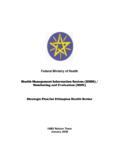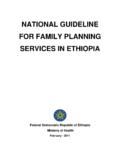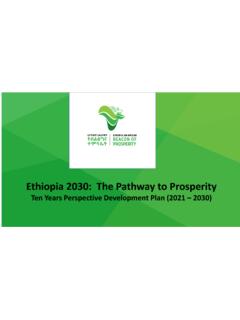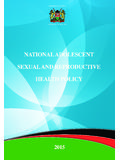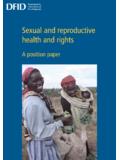Transcription of NATIONAL REPRODUCTIVE HEALTH STRATEGY - PHE …
1 Federal Democratic Republic of EthiopiaMINISTRY OF HEALTHNATIONAL REPRODUCTIVE HEALTH STRATEGY2006 - 2015 March 2006iiiTABLE OF CONTENTSList of abbreviations ..ivAcknowledgements ..vPreface ..viExecutive Summary ..viiINTRODUCTION .. 1 SECTION I REPRODUCTIVE HEALTH Environment ..3 Poverty ..3 Education ..3 Legal Environment ..4 Status of Women ..4 HEALTH Care System ..5 SECTION II Strategies to Address Key REPRODUCTIVE HEALTH Outcomes ..6 The Social and institutional parameters of women s HEALTH ..8 Fertility and family planning ..12 Maternal and newborn HEALTH ..16 HIV/AIDS ..20RH of young people ..24 REPRODUCTIVE Organ Cancers ..28 SECTION III Strengthening Supporting Systems in the HEALTH Sector ..31 Prioritizing RH ..31 Responding to Diverse Social Contexts ..32 Human Resource Development and Capacity Building ..33 HEALTH Management Information Systems (HMIS), Monitoring and Evaluation (M&E) and Research.
2 34 SECTION IV The Way Forward ..35 References ..36 NATIONAL REPRODUCTIVE HEALTH STRATEGY2006-2015ivLIST OF ABBREVIATIONSART Antiretroviral TherapyARV AntiretroviralCBOs Community Based OrganizationsCSWs Commercial Sex Workers DHS Demographic HEALTH SurveyEmOC Emergency Obstetric CareEPHA Ethiopian Public HEALTH AssociationESOG Ethiopian Society of Obstetricians and GynecologistsFGAE Family Guidance Association of EthiopiaFGC Female genital cuttingFHD Family HEALTH DepartmentFHI Family HEALTH InternationalFP Family PlanningHAPCO HIV/AIDS Prevention and Control OfficeHEWs HEALTH Extension WorkersHIV/AIDS Human Immunodeficiency Virus/Acquired Immunodeficiency SyndromeHMIS Management Information SystemsHEP HEALTH Extension Program HTP Harmful Traditional PracticeICPD International Conference on Population and DevelopmentIDP Internally displaced peopleIEC/BCC Information Education and Communication/Behavioral Change
3 CommunicationHSDP HEALTH Sector Development ProgramMCH Mother and Child HealthMDGs Millennium Development GoalsMOFED Ministry of Finance and Economic DevelopmentMOH Ministry of HealthMYSC Ministry of Youth, Sports and CultureNCTPE NATIONAL Committee on Traditional Practice in EthiopiaNGO Nongovernmental OrganizationPAC Post Abortion CarePASDEP Plan for Accelerated and Sustainable Development to End PovertyPLWHA People Living With HIV/AIDSPMTCT Prevention of Mother to Child TransmissionRH REPRODUCTIVE HealthSTIs Sexually Transmitted InfectionsTB TuberculosisTBA Traditional Birth AttendantTFR Total Fertility RateUNAIDS United Nations Programme of HIV/AIDSUNFPA United Nations Fund for Population ActivitiesUSAID United States Agency for International DevelopmentVCT Voluntary Counseling and TestingYRH Young People s REPRODUCTIVE HealthWHO World HEALTH OrganizationACKNOWLEDGEMENTSThis REPRODUCTIVE HEALTH STRATEGY is the product of countless hours of consultations with a wide range of stakeholders at both the NATIONAL and Regional Level.
4 The priority issues are drown from ideas and concepts, which are firmly grounded in the input of NATIONAL -level experts, Re-gional HEALTH Bureau (RHB) representatives, program managers and implementers, community members, non-governmental organizations (NGOs), and other members of the RH community. The Ministry of HEALTH (MOH) is grateful to all those who participated in the consultations, and it hopes that such broad-based participation, support, and ownership continues throughout the STRATEGY s implementation process. The MOH would like to acknowledge the financial and technical support of UNFPA Field Office, and all individuals and institutions who collaborated and contributed towards the successful preparation of the NATIONAL RH STRATEGY for MOH would also like to thank Population Council for providing technical assistance through-out the STRATEGY development process.
5 Special thanks go to the members of the RH Task Force, particularly to members of the Coordinating Committee and working groups established to as-sist in the formulation of the NATIONAL RH STRATEGY . Last but not least, the MOH would like to appreciate the efforts made by all program managers and technical assistants in the Family HEALTH Department, in developing and producing this im-portant document. Dr. Tesfanesh Belay CNM, MD, MPH Head, Family HEALTH Department Ministry of HealthvPREFACE The Government is committed to enhance the REPRODUCTIVE HEALTH (RH) status of women, men and young people of Ethiopia. This STRATEGY reaffirms that commitment by setting forth a tar-geted and measurable agenda for the next decade. The NATIONAL RH STRATEGY builds on a number of notable initiatives undertaken to serve the HEALTH needs of all Ethiopians. Included among these are the 1993- HEALTH policy, which was followed by formulation of a comprehensive HEALTH Sector Development Program (HSDP) in 1998, and the recent HEALTH Extension Program (HEP).
6 And currently is PASDEP, which gives priority to RH/FP. As a vehicle for the implementation of the HEALTH policy, HSDP is a long-term strategic framework based on principles and concepts of the Sector Wide Approach. The HEP is an innovative com-munity-based approach directed at availing preventive, promotive and some curative services near the household In this regard, the vision of the Government can only become a reality if the implementation process remains consensual, accelerated, flexible, and participatory. The development of the NATIONAL RH STRATEGY builds on the existing HEALTH policy, HSDP, and the HEP, while at the same time seeking to enhance the effectiveness of the HEALTH system in meeting the targets of PASDEP and the Millennium Development Goals (MDGs). The NATIONAL RH STRATEGY is the outcome of a continuous consultative process involving relevant governmental agencies, NGOs, stakeholders at international, NATIONAL , federal and regional level, and community members across the country.
7 As identified in these consultations, the NATIONAL RH STRATEGY addresses a set of critical issues that are outlined in the four sections of this document. The goal of this STRATEGY is built on the momentum occasioned by the Millennium Development Goals to garner the multicultural support needed to meet the REPRODUCTIVE and sexual HEALTH needs of our culturally diverse population - one characterized by its youthfulness, geographic dispersion, conjugality, and persisting gender this juncture, it is important to emphasize that the NATIONAL RH STRATEGY will require a logical, stepped implementation plan. Such a plan will help address the identified actions to achieve an optimum RH for all Ethiopians. The complimentary role of NGOs, partners and other stakeholders will be very useful not only in the preparation of the implementation plan, but also in participa-tion of actual execution of activities.
8 Finally, on behalf of the Federal Ministry of HEALTH , I would like to take this opportunity to express my gratitude to all partners for their continued support in this endeavor. I also appeal to all of our partners in HEALTH and development to contribute for the successful implementations of this strat-egy and to use this NATIONAL RH STRATEGY as a guiding tool in your future activities. Tedros Adhanom Ghebreyesus (PhD). Minister of HealthNATIONAL REPRODUCTIVE HEALTH STRATEGY2006-2015viEXECUTIVE SUMMARYThis document is the culmination of a vision, formulated over the years of NATIONAL REPRODUCTIVE HEALTH (RH) needs assessment. Lead by the Ministry of HEALTH and undertaken in collaboration with representatives of the RH community, the FMOH called upon the REPRODUCTIVE HEALTH com-munity to identify RH needs and priorities; achieve consensus on the appropriate scope of RH services; and ultimately, develop a NATIONAL RH STRATEGY .
9 Guided by a NATIONAL Coordinating Committee, the process of STRATEGY formulation has been both thorough and meticulous. It has included countless consultations with stakeholders at na-tional and region levels, extensive literature reviews, the compilation of region-specific technical briefs, and the preparation of this STRATEGY . Programmatically, this STRATEGY reflects three overriding priorities. It supports the nation s com-mitment to achieving the Millennium Development Goals (MDGs) by 2015; it responds to the socioeconomic and demographic realities that shape RH generally; and it reflects the notable advances realized in the HEALTH sector over the past decade. The objectives of this RH STRATEGY is subsumed within the STRATEGY s overall goal statement, which is to: Build on the momentum occasioned by the Millennium Development Goals to garner the multisectoral support needed to meet the REPRODUCTIVE and sexual HEALTH needs of our culturally diverse population - one characterized by its youthfulness, geographic dispersion, conjugality, and persisting gender the household and community as vehicles for change, seeking more effective inte-gration across the HEALTH sector, mainstreaming RH and ensuring its place in the NATIONAL devel-opment agenda, building capacity and effective utilization of the scarce human resources, and to confront head-on the demographic, cultural, geographic diversity of Ethiopia a diversity that belies simple solutions or single approaches are the five main strategic approach to be followed to achieve the set goals.
10 Six priority areas are identified from the large scope of service under RH umbrella as intervention: the social and cultural determinants of women s REPRODUCTIVE HEALTH ; fertility and family planning; maternal and newborn HEALTH ; HIV/AIDS; RH of young people; and REPRODUCTIVE organ cancers. The summaries of the sections include three levels of analysis: the community , which comprises the broader social and cultural context of each HEALTH issue; the system , which looks at opportunities arising from the delivery of HEALTH care services; and policy , which examines the institutional and normative frameworks within which decisions are made. Strengthening the legal frameworks that protect and advance women s REPRODUCTIVE HEALTH rights; prioritizing the attainment of age of marriage; increasing educational attainment and re-ducing the acceptability of all forms of FGC are the strategies outlined to improve the reproduc-tive HEALTH status of women and elimination of HTPs.
